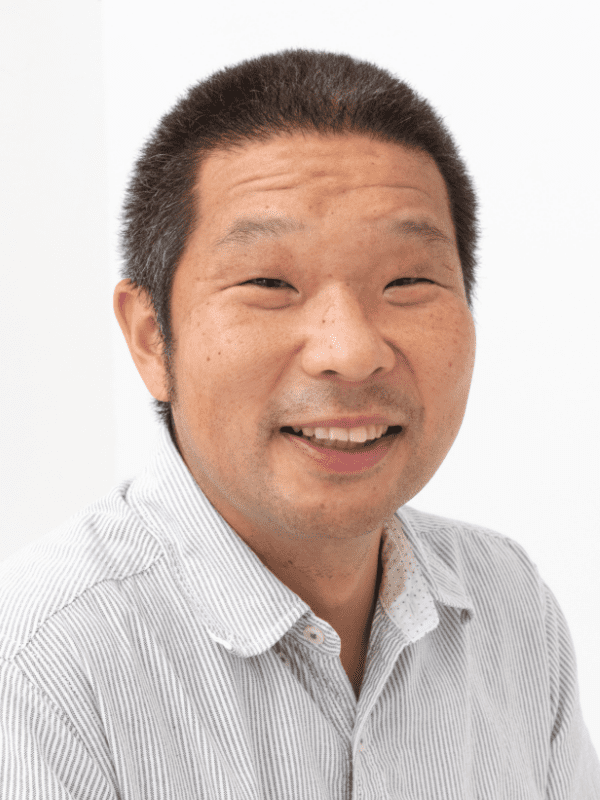About Kenji MORIprofile
Kenji MORI was born and raised in a home of coral artisans and through the family business became familiar with the beautiful and special material called coral. Perhaps because of this, he has a lot of curiosity and interest in various materials and how they can be handled.
One of his hobbies is visiting second hand bookstores. He is a passionate book lover and has collected a mountain of reference books. From his collected books (picture books, ukiyo-e, etc.), he drew upon classical subjects and comical modern expression. They are the two facets that are his major artistic style. In the end though I believe it is a pursuit of character expression. This is carved as netsuke from natural materials. Mr. Mori’s style gives a fully formed, pop and cute impression, and is both heavy and light.
When it is rolled in the palm of the hand, there is nothing disagreeable, and it brings a smile to your cheeks. I think this is highly appealing. Even as a father of two, somewhere within Mr. Mori a child’s heart still resides and this is apparent in his work. Perhaps therein is the reason his work is admired. It could be that the location of that precious child’s heart within the artist is indeed paradise.
Tatsushi HASHIMOTO,
Gallery Hanakagesho

Interview & Movie
Kochi is a place that prospered as a major world producer of jewelry corals. I was born in a family of coral artisans, and became familiar with coral from an early age. Both my parents worked, my mother as a nurse and my father as a coral artisan. When necessary, I was in and out of my father’s studio, but I remember seeing light pink roses made from coral lined on the worktable, picking them up and saying, “These small roses are like cake decorations; they are cute and look delicious.”
Perhaps because of this influence, I grew up liking small and cute works. Today I am a netsuke and coral craftsperson, but since following in the footsteps of my father, I have also become attracted to coral variations of red, peach, white, along with gentle and deep colors. I carve everyday, and I am sincerely grateful that I was born into a family of coral artisans.
I am still only mid journey but I will do my best to convey the merits of jewelry corals, if even only a little.
Because jewelry corals* take approximately one hundred and twenty years to grow to the size of a person’s little finger, I always inspect the coral and carefully design the work before carving so that, as much as possible, little is wasted. Even so, because it is a natural material, unexpected hollows and cracks can appear while carving, but this is part of creating the work, and the thrill when I can work out how to utilize them is motivation to continue.
Kenji MORI
*About corals
Corals are known as reef-building, jewelry corals, or deep-sea corals, depending on their habitat.
Reef-building corals are found in shallow waters, about 1 to 100 meters below the seafloor where people can dive, and are a collection of small sea anemon-like creatures called polyps.
jewelry corals, on the other hand, are found at depths of 400 to 800 meters.
Jewelry coral is harder and denser than reef building coral, and also beautiful in red and white, so it is used for jewelry and crafts (Reef building coral is very low in density, so it is not suitable for jewelry and crafts).
Corals that live at depths of 1,200 to 1,800 meters are called deep-sea corals.
For this exhibition, Kenji MORI has produced a time-lapse video on the production of the coral works in his studio. Here is an accompanying note.
Tatsushi HASHIMOTO
Kenji MORI Brief history
1974: Born Kochi Prefecture
- 1994:
- Graduated in oil painting at Nara College of Art.
Joined the Tetsuzan Nara Ittōborikōbō (Tetsuzan Nara Woodcarving Workshop) - 2000:
- Returned to Kochi to become a coral artisan of the family business.
- 2006:
- Began teaching himself netsuke carving.
Gallery Exhibitions
- 2009:
- NO BORDER 4, The Museum of Art, Kochi
- 2010:
- Hitori Kai Bijutsu, Hiroshima Museum of Contemporary Art
- 2012:
- RT ZOO, Museum of Art, Warakoh, Kochi
Amagakeru Tori, Tabisuru netsuke (Soaring Birds, Travelling Netsuke),
Mizuta Museum, Josai University, Saitama - 2014:
- Prince Takamado netsuke collection & court attire, Kure Municipal Museum of Art
- 2017:
- Mori Kenji, Special exhibition, Kyoto Seishu Netsuke Art Museum
- 2018:
- Netsuke, Stylish Accessories, Crafts of Edo, Special Presentation of The Prince Takamado Collection, Hiroshima Museum of Art
Public Collections
- Princess Takamado Contemporary Netsuke Collection
- Kyoto Seishu Netsuke Art Museum
- Mitsuko Masui Collection, Azabu University
- Public works collection, Umeå City, Sweden
